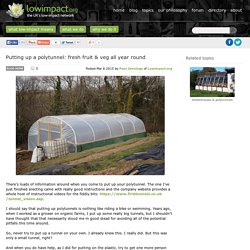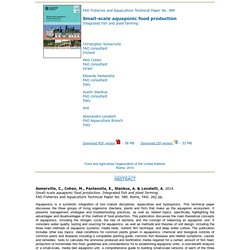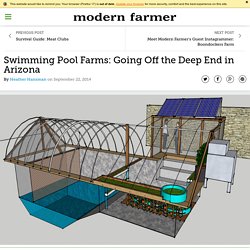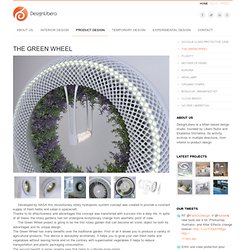

Windowfarms Living Pantry ReFresh Plan & Vertical Indoor Gardens. Getting Started With Aquaponics. Putting up a polytunnel: fresh fruit & veg all year round -Low impact living info, training, products & services. There’s loads of information around when you come to put up your polytunnel.

The one I’ve just finished erecting came with really good instructions and the company website provides a whole host of instructional videos for the fiddly bits: I should say that putting up polytunnels is nothing like riding a bike or swimming. Years ago, when I worked as a grower on organic farms, I put up some really big tunnels, but I shouldn’t have thought that that necessarily stood me in good stead for avoiding all of the potential pitfalls this time around. So, never try to put up a tunnel on your own. I already knew this. And when you do have help, as I did for putting on the plastic, try to get one more person than you think you’ll need. I found myself wrestling with hoops and desperately wishing that I had someone to hold the other end of the tape measure.
Also, make sure that you have all of the tools you need. Charge your drill! Setting out is the most important stage. FAO Fisheries and Aquaculture Department. Small-scale aquaponic food production. Integrated fish and plant farming. Somerville, C., Cohen, M., Pantanella, E., Stankus, A.

& Lovatelli, A. 2014. Small-scale aquaponic food production. How To Make a DIY Pallet Deck In One Afternoon With Only $300. How To Build a Gravity-Based PVC Aquaponic Garden Very Easily. Swimming Pool Farms: Going Off the Deep End in Arizona. By Heather Hansman on September 22, 2014 Graphic shows the Garden Pool's model. / Courtesy Garden Pool Instead of water wings and inner tubes, Dennis and Danielle McClung’s backyard pool in Mesa, Arizona, is filled with tomato plants, grape vines and wheat.

There’s a chicken coop and a fish pond, and the food that comes out of the pool, from tilapia to tomatoes, feeds the McClung family of five. It’s a system that took a few frustrating failures to perfect, but now the McClungs hope to take swimming-pool farming international. When the McClungs bought the foreclosed home in 2009, the backyard was a suburban wasteland with a cracked, concrete, in-ground pool. The McClungs has some farming and building experience — Dennis worked on a dairy farm and at Home Depot, and Danielle grew up on small farm in Ohio — and they’d been trying to become as self-sufficient as possible. It starts with a pond — in their case, the deep end of the pool — which is full of tilapia and duckweed. AeroGarden: Patio, Lawn & Garden. OGrow Deluxe Walk-In 3 Tier 6 Shelf Portable Greenhouse : Camping And Hiking Equipment : Patio, Lawn & Garden.
The Green Wheel - designlibero. Developed by NASA this revolutionary rotary hydroponic system concept was created to provide a constant supply of fresh herbs and salad in spacecraft.

Thanks to its effectiveness and advantages this concept was transferred with success into a daily life. In spite of all these, the rotary gardens had not undergone evolutionary change from aesthetic point of view. The Green Wheel project is going to be the first rotary garden that can become an iconic object for both its advantages and its unique design. The Green Wheel has many benefits over the traditional garden. First of all it allows you to produce a variety of agricultural products. The second benefit is larger growing area that helps to cultivate more plants. Maximized illumination is another advantage of the project. The Gravity’s effect helps to optimize herbs and vegetables production. Natural Pools - Natural Swimming Pools and Ponds. Baker Lighting Lab - University of Oregon. Entry No. 15 17 February, 2014 Author: Josie Baldner Taras Sgibnev Colour Injector from Taras Sgibnev on Vimeo.

The Colour Injector Lamp was designed by Taras Sgibney to portray the way that three colors red, green, and blue (RGB) interact with each other in digital interfaces. The lamp has three syringes with red, green, or blue inks inside them. Entry No. 14 4 February, 2014 Author: Veronika Jonsson Featuring In-Tenta | Sinato | Philips Lumiblade OLEDs, also known as organic LEDs, work similarly to their LED namesake. The difference between LEDs and OLEDs The semiconducting layers of LEDs are built in crystals of inorganic material while OLEDs are created using organic material.
OLEDs also produce a dramatically different light quality than LEDs or any other electric light source. New Frontiers.